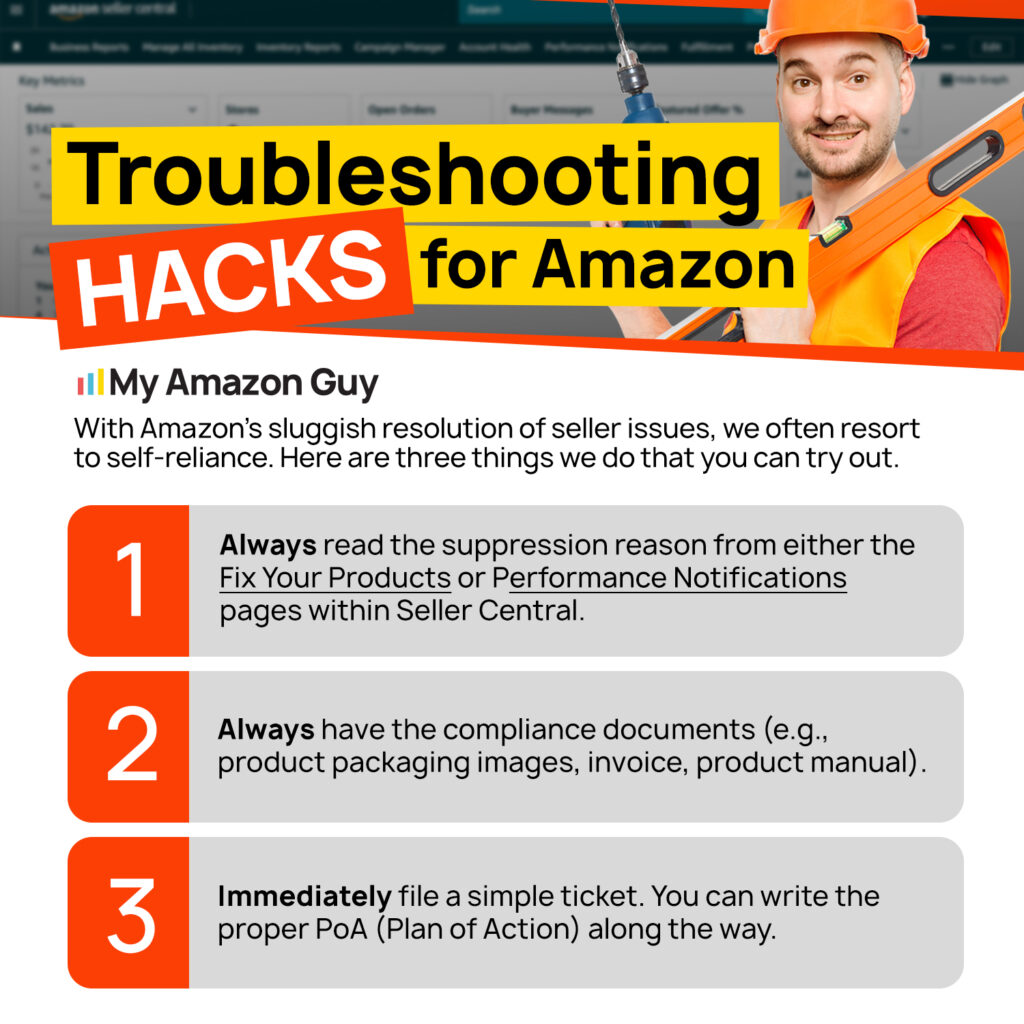With your product not getting the traction it needs, are you thinking of buying fake positive reviews? Think again, Amazon review manipulation is taken seriously by Amazon and can come with steep consequences.
The truth is, competition on the Amazon marketplace is intense, so your product can easily get buried in search results, and without strong reviews, it’s tough to gain visibility or win customer trust. That’s why some sellers look for shortcuts by paying for reviews in hopes of boosting their ratings quickly.
But here’s the catch: engaging in review manipulation can result in listing suppression, product removal, or worse, account suspension. However, despite the risks, many sellers still try to game the system.
Understanding how review manipulation works not only helps you stay compliant but also gives you the knowledge to identify and report competitors who violate Amazon’s policies. In this article, we’ll discuss what counts as review manipulation, which tactics to avoid, what to do if you’re wrongly accused, and how to deal with dishonest competitors.
Table of Contents
Why Amazon Product Reviews Matter
As a shopper, how do you determine whether you can trust a seller or their product? Simple, you look at the reviews to see if the product matches what’s advertised.
That alone shows how important reviews are. But that’s not the only reason why reviews matter on Amazon. Here’s why:
- Most shoppers rely on reviews to confirm product quality, reliability, and value. In fact, studies show that around 95% of buyers trust online reviews when making purchase decisions.
- Positive reviews can tip the scale in your favor, encouraging customers to hit “Buy Now”. Negative reviews, while tough to receive, help buyers set realistic expectations and reduce returns.
- Amazon’s A10 algorithm factors in review quality and quantity when ranking products in search results. More genuine reviews = better visibility.
- Reviews give your brand credibility and help build long-term customer trust and loyalty, especially when you engage with feedback professionally.
- Reviews can highlight issues you might have missed and point to areas for improvement, helping you refine your products and customer experience.
What Is Amazon Review Manipulation?
Because product reviews heavily impact buyer decisions, some sellers attempt to manipulate them. Amazon review manipulation is the act of trying to influence product reviews in dishonest or deceptive ways.
This includes any attempt to boost a product’s rating or damage a competitor’s reputation. These actions go against Amazon’s policies and can result in serious consequences.
Common Types of Amazon Review Manipulation
Review manipulation takes many forms. You might think what you’re doing is just encouraging feedback, but it could actually be a violation of Amazon’s policies.
Learning about these tactics can help you recognize what not to do, especially since ignorance won’t protect you from account-level consequences. It also helps you understand the situation better if Amazon flags your account or listings for review manipulation.
1. Paid Reviews
Sellers pay individuals, directly or through third-party services, to leave fake positive reviews. This falsely boosts a product’s credibility and misleads potential buyers.
2. Incentivized Reviews Disguised as Legitimate Purchases
Sellers may offer free products, refunds, or discounts after purchase in exchange for a “genuine” review. These tactics are often masked as regular sales but still violate Amazon’s policies.
3. Fake Customer Accounts or Bots
Some sellers create fake buyer accounts or use bots to leave positive reviews for their own products or negative ones for competitors. This artificially distorts product ratings and damages trust.
4. Review Swapping with Other Sellers
This involves two or more sellers exchanging reviews for each other’s products, usually under the radar. It’s a mutual arrangement that still counts as manipulation.
5. Friends and Family Reviews
Asking relatives or close contacts to leave glowing reviews may feel harmless, but it skews the authenticity of customer feedback. Amazon detects and penalizes this practice as review bias.
6. Upvoting Positive Reviews/Downvoting Negative Reviews Illegally
Manipulating the helpfulness vote count to boost positive reviews or bury negative ones is also a violation. Some sellers use networks or software tools to carry out this tactic.
Amazon’s Stance: Anti-Manipulation Policy Overview
Amazon takes the integrity of customer reviews seriously, and any attempt to manipulate reviews, whether through false, misleading, or inauthentic content, is strictly prohibited. The company’s anti-manipulation policy aims to maintain an honest and reliable shopping experience for customers, which is central to the trust placed in the platform.
How Amazon Combats Review Manipulation
To maintain a trustworthy marketplace, Amazon employs a combination of automated systems, artificial intelligence, and manual reviews to detect and penalize offenders. These mechanisms include:
- AI systems and machine learning help identify suspicious patterns of review activity that could indicate manipulation.
- Amazon’s team reviews flagged sellers and suspicious activities, taking action such as removing products or suspending accounts.
- In severe cases, Amazon files lawsuits against sellers and parties involved in large-scale review manipulation. This includes partnering with regulatory bodies like the Federal Trade Commission.
- Amazon continuously updates its policies to close loopholes and ensure compliance. Sellers are notified about changes to help them remain compliant.
Consequences of Amazon Review Manipulation
If a seller is found to violate Amazon’s review manipulation policy, the consequences can be severe. Below are the potential repercussions of engaging in review manipulation:
- Account Suspension or Termination
Amazon may immediately suspend or permanently terminate the seller’s account, removing their ability to access their products or make sales on the platform.
- Removal of Reviews
Any fraudulent or manipulated reviews will be removed, potentially damaging the product’s reputation and sales performance.
- Product Delisting
In some cases, Amazon may delist the seller’s products entirely, preventing them from being sold on the marketplace.
- Withholding or Forfeiting Payments
Amazon may withhold or forfeit payments due to the seller, impacting their cash flow and ability to reinvest in their business.
- Legal Action
Violations of Amazon’s review manipulation policies can lead to legal action. This may include civil and criminal penalties, as review manipulation could also violate state and federal laws.
- Lawsuits and Monetary Judgments
Amazon may pursue lawsuits against sellers engaged in large-scale manipulation schemes, with the potential for significant financial penalties exceeding the seller’s annual revenue.
What to Do If Amazon Accuses You of Review Manipulation
Whether it was intentional or not, being flagged for review manipulation by Amazon is serious. You might have unknowingly violated a policy, and now you’ve received a performance notification or even faced account or ASIN suspension.
Knowing how to respond is crucial to prevent further damage to your account. Our Amazon agency has put together this clear, step-by-step guide to help you take the right action:
Step 1: Read the Notification Carefully
Don’t rush to appeal. First, understand exactly what Amazon is accusing you of, and look for specific language like:
- “We believe you may have offered compensation for reviews.”
- “Suspicious customer review activity was detected…”
Step 2: Review Amazon’s Review Policies
Check Amazon’s Customer Reviews policies to pinpoint what triggered the warning. Violations include:
- Offering incentives for reviews.
- Using friends, family, or employees to leave reviews.
- Asking customers to revise or remove negative reviews.
- Adding inserts requesting positive feedback.
Step 3: Identify the Root Cause
Investigate all touchpoints: messaging, packaging, inserts, employee actions, even third-party services. Be honest with yourself about any unintentional violations, and then educate anyone involved, including team members or affiliates.
Step 4: Prepare Your Plan of Action (PoA)
When appealing, Amazon expects a Plan of Action that:
- Admits the mistake and shows understanding of the violation.
- Describes corrective actions already taken (e.g., removing affected inventory or messaging updates).
- Outlines preventive measures to avoid future issues (e.g., employee training, policy updates).
Step 5: Write a Professional, Precise Appeal
Avoid emotional language. Be concise, factual, and solution-focused. Include:
- Contact info related to any services or accounts involved.
- Documentation (emails, receipts, etc.) if relevant.
Specific steps you’ve taken and will take.
Step 6: Submit and Wait
Go to Seller Central > Performance > Account Health > Policy Compliance, then select the specific violation. Use the option provided to submit your Plan of Action, include all required details and any supporting documents, then click Submit.
Avoid sending multiple follow-ups and keep a record of your submission. Be patient while Amazon reviews your appeal and responds.
Seen a New Seller Central Update? Let Us Know!
Amazon Seller Central constantly updates its interface. If you spot a change we missed, let us know using the form below!
How to Report Competitor Review Manipulation
But what if the review manipulation isn’t coming from you but is aimed at you? Maybe you’ve noticed a sudden spike in 1-star reviews that don’t match the product or seem oddly robotic.
Then, it’s possible a competitor is using fake buyer accounts to hurt your listing performance. Here’s how you can take action:
1. Identify Suspicious Reviewer Profiles
Click on the reviewer’s name and check their profile. If most of their reviews are 1-star ratings, it’s a red flag; copy their profile link for documentation.
2. Track Down Order IDs
Visit Performance > Account Health > Voice of the Customer, look for listings with high NCX rates, and match the review timing with customer orders. You might uncover buyer names or return order info that supports your case.
3. Report Abuse in Seller Central
Go to Help > “My issue is not listed”, describe that the issue is review manipulation, and then provide details such as the buyer profile involved, specific review content, and any relevant reference numbers (e.g., ASIN, order ID). After entering all the information, click Continue to submit the report.
4. Send a Cease and Desist
If you identify a competitor likely behind the abuse, message them through their Amazon storefront. You can also send a formal cease and desist email or letter if contact info is available.
Keep in mind: Not every negative review is fake, and proving malicious intent can be tough. But staying proactive helps protect your brand and signals to Amazon that you’re taking violations seriously.
FAQs About Amazon Review Manipulation
How can I report Amazon review manipulation?
You can report suspicious reviews directly to Amazon:
- Scroll to the questionable review
- Click “Report”
- Select the reason and submit
If you suspect broader manipulation, contact Amazon Seller Support with details.
Does Amazon review reviews?
Yes. Amazon uses automated systems and human moderation to review submitted reviews. They remove reviews that violate their Community Guidelines or Customer Reviews policies, especially if manipulation is suspected.
Can I edit an Amazon review as a seller?
No. Sellers cannot edit customer reviews. However, you can respond publicly to reviews or use the Customer Reviews on Amazon tool (if eligible) to send a templated message to buyers who left a critical review.
How can I tell if an Amazon review is fake?
Fake reviews often share a few signs:
- Overly generic or vague language
- Multiple 1-star reviews posted in a short time
- Reviews that sound unnatural or overly promotional
- Reviewers with no profile photo or minimal activity
Why does Amazon have a fake review problem?
Amazon’s open marketplace makes it easy for third-party sellers to operate, but that also creates room for abuse. Some sellers try to boost product rankings with incentivized or fake reviews. While Amazon works to remove these, the sheer volume of listings and reviews makes complete prevention difficult.
Long-Term Gains Over Shortcuts
Manipulating Amazon reviews may seem like a shortcut, but it comes with serious risks that can damage your account and credibility. Staying informed about what counts as manipulation helps you avoid costly mistakes.
Instead of gaming the system, focus on delivering great products, providing excellent service, and earning reviews the right way. This not only keeps your account safe but also builds lasting customer trust.
Got a warning from Amazon about review manipulation? Not sure what steps to take next? Contact our Amazon agency today; our experts are ready to help you resolve it and protect your account.





